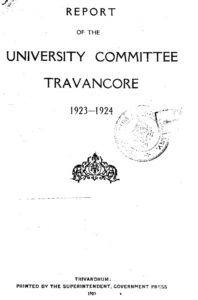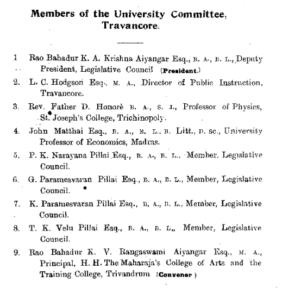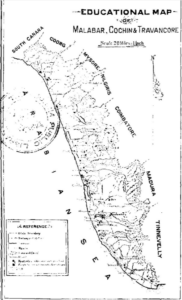Over a century ago, on 15 April 1923, the Travancore government under Maharaja Moolam Thirunal Rama Varma constituted a pivotal committee to examine the feasibility of establishing a new university tailored to the state’s needs.
Published Apr 20, 2025 | 4:24 PM ⚊ Updated May 24, 2025 | 7:43 PM

From campus waste to solar power: How Kerala’s institutions earned crores in green revenue
Synopsis: The idea of establishing a university in Travancore was first hinted at by Dr. William Miller, a member of the Indian Education Commission of 1882. Over the next decades, this vision gained momentum.
Long before the state of Kerala was even formed, a visionary document quietly emerged from the royal corridors of Travancore — the ‘Report of the University Committee Travancore’ in 1925.
Little known today, this visionary document quietly laid the intellectual foundation for what would become the sixteenth university in India.
Twelve years later, in 1937, the University of Travancore was born.
With the creation of Kerala in 1954, and the enactment of the Kerala University Act in 1957, it was renamed the University of Kerala.
But behind these milestones lies a lesser-known chapter in Kerala’s academic legacy — one of princely ambition, progressive minds, and a forgotten report that dared to imagine a modern university in a pre-independence world.
Over a century ago, on 15 April 1923, the Travancore government under Maharaja Moolam Thirunal Rama Varma constituted a pivotal committee to examine the feasibility of establishing a new university tailored to the state’s needs.
Chaired by KA Krishna Aiyangar, then Deputy President of the Legislative Council, the nine-member committee was tasked with reviewing the 1919 interim report of an earlier committee and the pressing demands raised in the Travancore and Madras Legislative Councils.

The Report
The committee held its first meeting on 28 May 1923 and concluded its deliberations on 26 December 1924.
Its mandate was clear: to revisit earlier recommendations in light of recent socio-political developments, including the resolution moved by TK Velu Pillai in 1922 for an immediate establishment of a teaching and residential university.
The committee’s findings got eventually published in 1925.
The idea of establishing a university in Travancore (now Thiruvananthapuram) was first hinted at by Dr. William Miller, a member of the Indian Education Commission of 1882. Over the next decades, this vision gained momentum.
In 1912, Dr. AC Mitchell, retiring Director of Public Instruction, strongly advocated for it. The press echoed the demand.
By 1914, Principal LC Hodgson and Professor RS Lepper had both highlighted the need for Honours courses and a separate university.
Sir Harold Stuart, during a 1915 Madras University convocation, proposed regional universities, including one for the West Coast.

Members
In response, the Travancore government set up a representative committee in 1917 to explore the feasibility of a university.
Though its 1919 report wasn’t unanimous, it marked a significant step toward the idea.
Tensions rose when a 1922 Bill in the Madras Presidency ignored Travancore’s educational interests.
This prompted Velu Pillai to move a resolution in the Travancore Legislative Council, calling for a teaching and residential university.
The resolution, supported in spirit, was withdrawn after the government promised to form a committee to examine the matter — a major turning point in Travancore’s higher education journey.
A 1919 report underscored the pressing need for a university in Travancore, citing critical challenges faced by students and teachers tied to the distant University of Madras, located nearly 600 miles away.
The report noted that the Madras University functioned solely as an examining and degree-awarding body, offering little academic engagement for affiliated colleges.
Teachers in Travancore struggled to stay connected with university activities, and students were deprived of access to libraries, lectures, and academic discourse. Mofussil institutions also lacked proper representation in the university’s governance.
These shortcomings were attributed not to malice but to structural flaws and geographical disconnect. The report emphasised that a state university could address these issues and foster better academic standards. It concluded that the creation of a Travancore University was not just desirable but necessary.
The findings were corroborated by the 1923 committee also.
Despite initial proposals for a unitary university at Aruvikkarai and considerations of Alwaye and Trichur to establish an All-Kerala institution, a 1923 committee ultimately recommended Trivandrum (Thiruvananthapuram) as the most viable location for the University of Travancore.
Alternative sites such as Akkulam, and Kovalam were evaluated for cost, accessibility, and development potential.
However, the committee cited Trivandrum’s existing infrastructure, availability of space, and suitability for a residential university as decisive advantages.

A map
“The availability and cost of an adequate campus with ready-made buildings are vital factors,” the report noted, adding that even proponents of other sites acknowledged Trivandrum’s strengths—especially if a federal university model was to be adopted.
The decision solidified Trivandrum’s role as Kerala’s academic nerve centre, laying the foundation for what would become one of the state’s most iconic educational institutions.
And recommending that location involves shifting the offices of the Nair Brigade (the army of erstwhile Travancore).
The report also discussed in detail on the formation of the Senate, Academic Council and appointment of the Chancellor and Vice Chancellor.
On the 26th birthday of Sree Chithira Thirunal in 1937, the University of Travancore — now the University of Kerala — was born through a royal proclamation by the Maharajah himself, who also became its first Chancellor.
CP Ramaswamy Aiyer, then Diwan of Travancore, took charge as the first Vice-Chancellor. Interestingly, there was even an attempt, albeit unsuccessful, to bring Albert Einstein as the inaugural V-C.

The Founder Chancellor along with Pro-Chancellor, VC, PVC and Registrar.
courtesy – University of Kerala
Modelled after top British universities, this institution marked a pivotal moment in Kerala’s educational history.
Its roots can be traced back to two pioneering institutions: University College and the Trivandrum Observatory.
University College began as Maharaja’s Free School in 1834 under Swathi Thirunal, and grew into a full-fledged college by 1866, affiliated to Madras University.
When Travancore University was formed, the college’s departments briefly became university departments until the transition to Kerala University in 1957.
The Trivandrum Observatory, established in 1838, also came under the university’s umbrella and remains its oldest institution.
Initially, ten colleges previously affiliated to Madras University came under Travancore University.
Post the formation of Kerala state in 1954, the Kerala University Act of 1957 officially renamed it the University of Kerala, with campuses in Thiruvananthapuram, Ernakulam, and Kozhikode.
Over time, regional demands led to the formation of new universities — Calicut (1968), CUSAT (1971), Kerala Agricultural University (1971), and MG University (1983) — narrowing Kerala University’s jurisdiction to Thiruvananthapuram, Kollam, Alappuzha, and parts of Pathanamthitta.
The University of Kerala’s story is more than a timeline of milestones — it is the culmination of seeds sown by early reformers and educationists, a robust academic ecosystem.
The 1925 report of the University Committee Travancore, now a largely forgotten document, was far ahead of its time. It spoke of access, equity, and academic excellence at a time when such ideas were scarcely entertained in princely India.
(Edited by Majnu Babu).
